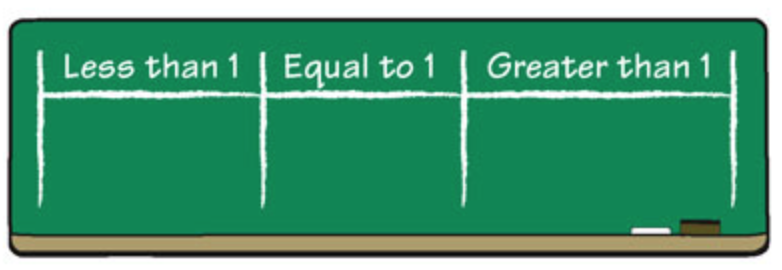Fractions Greater Than, Less Than, and Equal to 1
Purpose
Fractions
Materials
White board
Overview
Include this visual/chart on the whiteboard

Students will determine if given fractions are less than, equal to, or greater than 1. Students who are successful at this have already generalized the rule: fractions greater than 1 have numerators larger than their denominators; those that are less than 1 have numerators smaller than their denominators; the rest are equal to 1. If students found this activity hard, you may want them to go over the finished lists and try to articulate the rule.
About the sequence
Part 1 asks the class to determine whether given fractions are less than 1, equal to 1, greater than 1. Be sure there’s a balanced number of fractions in each category. Part 2 offers continued practice with placing fractions in each of the 3 categories of less than 1, equal to 1, and greater than 1. During this part, ask students to provide examples of fractions for the class to sort. The extension progresses to sorting mixed numbers, decimals, and fractions in relation to 1.
Part 1
Let’s determine if each fraction is less than 1, equal to 1, or greater than 1. For example, ![]() equals 1 so it would be placed in the “equal to 1” category. Now let’s try some more.
equals 1 so it would be placed in the “equal to 1” category. Now let’s try some more.
Examples:
 (less than 1 & clue is numerator is smaller than denominator)
(less than 1 & clue is numerator is smaller than denominator) (greater than 1 & clue is numerator is larger than denominator)
(greater than 1 & clue is numerator is larger than denominator) (equal to 1)
(equal to 1) (less than 1)
(less than 1) (less than 1)
(less than 1) (equal to 1)
(equal to 1) (less than 1)
(less than 1) (more than 1)
(more than 1) (less than 1)
(less than 1)
While children are enjoying their building of mastery, feel free to repeat. When children are eager for more, try Part 2.
Part 2
I’m going to ask for volunteers to share some fractions to sort. Be sure you have an example ready to go in case you’re selected. (If you are getting fewer examples in one category, you can ask students for examples for that category specifically.)
As always, when children seem excited for a new challenge, move on.
Extension
Here are some more fractions, mixed numbers and decimals to classify.
Examples:
- 1


- Eight fifths
- Two thirds
- 50
- .25

This work is licensed under a
Creative Commons Attribution-NonCommercial-NoDerivatives 4.0 International License.
